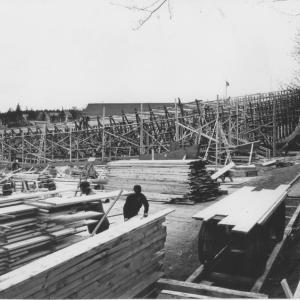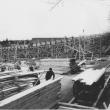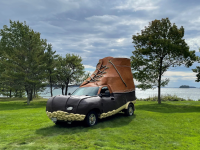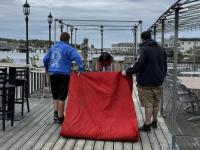Minesweeper Days, 1950s, Part III
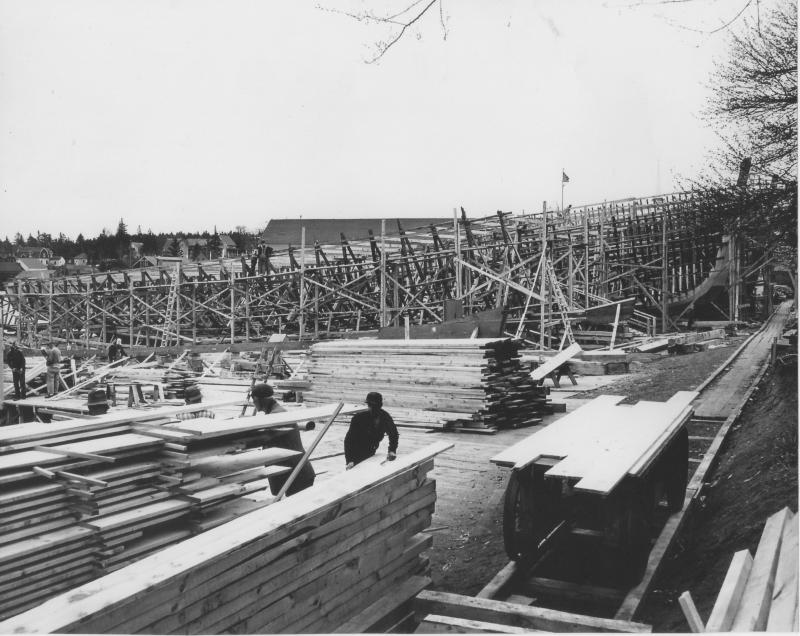 This 1953 East Boothbay view looks south to the Hodgdon yard building. The Lincoln Street yards are out of sight on the right. Four future minesweepers are shown, two with their tall stems in place on the far right, and two with their keels laid only. The men are working on extending the planking over the mudflats and on the scaffolding next to one of the skeletal ships. In the right foreground is the track and the handcar with short lengths of planking on top. Courtesy of Robert Rice
This 1953 East Boothbay view looks south to the Hodgdon yard building. The Lincoln Street yards are out of sight on the right. Four future minesweepers are shown, two with their tall stems in place on the far right, and two with their keels laid only. The men are working on extending the planking over the mudflats and on the scaffolding next to one of the skeletal ships. In the right foreground is the track and the handcar with short lengths of planking on top. Courtesy of Robert Rice
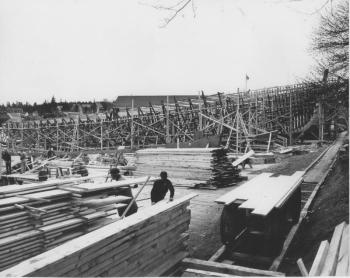 This 1953 East Boothbay view looks south to the Hodgdon yard building. The Lincoln Street yards are out of sight on the right. Four future minesweepers are shown, two with their tall stems in place on the far right, and two with their keels laid only. The men are working on extending the planking over the mudflats and on the scaffolding next to one of the skeletal ships. In the right foreground is the track and the handcar with short lengths of planking on top. Courtesy of Robert Rice
This 1953 East Boothbay view looks south to the Hodgdon yard building. The Lincoln Street yards are out of sight on the right. Four future minesweepers are shown, two with their tall stems in place on the far right, and two with their keels laid only. The men are working on extending the planking over the mudflats and on the scaffolding next to one of the skeletal ships. In the right foreground is the track and the handcar with short lengths of planking on top. Courtesy of Robert Rice
In March and April I wrote two articles on the shipbuilding done for the Navy in our region shipyards during World War II and the Korean War. Those large wooden vessels included rescue tugs, aircraft rescue boats, plane rearmament boats, subchasers, coastal transports, and lots of minesweepers. I also mentioned that Maine's being a little behind the times up in the northeast corner served it well at that time. Workers in states below had lost woodworking skills decades earlier to modern steel construction. Nevertheless, wooden ships were needed during those wars. I stressed the impact those boom times had on the village of East Boothbay, where most region minesweepers were built.
Bobby Holbrook
Back in the late 1980s, old friend Bobby Holbrook gave me a great explanation of a minesweeper's particular needs. “Minesweepers were wooden in order to work around magnetic mines, which were fixed in place by being moored below the surface and which were attracted to steel. Despite being wooden with most fittings bronze or stainless steel, minesweepers still needed degaussing gear to cancel out the magnetic field generated by the machinery on them.
“Every boat, whether wood or metal, has a magnetic field which you have to correct for by compensating the compass for deviation. A magnetic field causes a distortion between true north and magnetic north, but the magnetic field within each boat in the water distorts things too. All these factors have to be accounted for when you adjust the compass or they need to be canceled in a mine field. Degaussing cables, whether covering the whole ship or just the engine room, eliminate this field and allow passage through a mine field.
“The minsweepers used an operation similar to our fishing draggers today. Their cables went back to what they call paravanes which look like a torpedo with fins. The fins were angled such that the cables tended to separate. Between them was a steel cable that acted as a cutter. They would drag a whole area and just as fast as one of these mines would be funneled under those set of jaws back there, it would cut the mine's anchoring cable. When the mines surfaced, they would detonate them by firing guns at them.”
Local Naval shipbuilding
In January 1952, Sample's shipyard in Boothbay Harbor built the first Navy minesweeper launched in the U.S. after World War II. That 144-footer was followed down their ways by three more 144-footers, twelve 63-foot aircraft rescue boats, and four 171-foot minesweepers before 1958.
In East Boothbay, the Hodgdon yard and Goudy & Stevens combined during the Korean War to ease paperwork and get bonding, as they had in WWII. They launched 12 minesweepers for the Navy in the 1950s. The workforce multiplied from the yacht years’ number of under 100 for the combined yards to more than 450 men. Robert Rice described a couple of their clever solutions for the yards’ inherent limitations, so they could ramp up to nearly a mass-production operation.
Robert said most of the sweepers were framed out in the east-facing Hodgdon yard (now the marina) where there was more room than at Goudy's (now Hodgdon Yachts) on the south side of the little harbor. But that elbow room was on the Damariscotta River shore strung out north along Lincoln Street. The available land was mudflats, submerged at high tide. Building on the flats would necessitate that the men stand in the muck and drop their hammers daily as the water rose, maybe at half tide.
Making do
The solution was to plank over the flats. A platform of planking was constructed, with framing below a few feet high, all along the stretch to allow from three to six minesweepers to be under construction simultaneously. Their bows protruded into the Lincoln Street backyards. A wooden retaining wall was also constructed to prevent the backyards from slumping into the dug-out, graded dirt adjoining the planking.
Again given the cramped space between the planked decking and backyards, there was no room to run a little road to transport supplies along the bows of the multiple ships in progress. The solution was to lay a track about three feet wide, made of wooden 4x4s. The men pushed a handcar, complete with flanged wheels to keep it on the track. The handcar went back and forth along the 100-foot track loaded with tools, lumber, and fittings.
Bill Barlow told me his father Al, who used the family fishhouse abutting the most northerly minesweeper, had permission to retrieve (for his own use) any of the silicon bronze or monel fittings and fastenings that fell through the planking to the flats. Quite a windfall in those days!
Event Date
Address
United States

